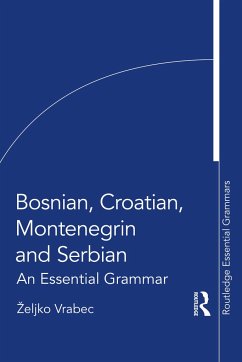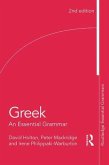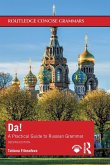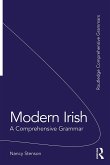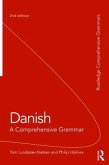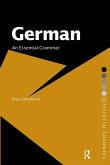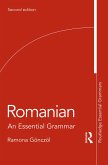- Broschiertes Buch
- Merkliste
- Auf die Merkliste
- Bewerten Bewerten
- Teilen
- Produkt teilen
- Produkterinnerung
- Produkterinnerung
Bosnian, Croatian, Montenegrin and Serbian: An Essential Grammar is intended for beginners and intermediate students who need a reference that explains grammar in straightforward terms. It covers all the main areas of the modern single BCMS grammatical system in an accessible way, and free from jargon. When linguistic terminology is used, it is explained in layman's terms, the logic of a rule is presented simply and near parallels are drawn with English. This book covers all the grammar necessary for everyday communication (reaching B1 and B2 of the CEFR, ACTFL Intermediate-Intermediate-…mehr
Andere Kunden interessierten sich auch für
![Greek Greek]() David HoltonGreek53,99 €
David HoltonGreek53,99 €![Da! Da!]() Tatiana FilosofovaDa!38,99 €
Tatiana FilosofovaDa!38,99 €![V Puti V Puti]() Anna KudymaV Puti44,99 €
Anna KudymaV Puti44,99 €![Modern Irish Modern Irish]() Nancy StensonModern Irish63,99 €
Nancy StensonModern Irish63,99 €![Danish Danish]() Tom Lundskaer-Nielsen (UK University College London)Danish62,99 €
Tom Lundskaer-Nielsen (UK University College London)Danish62,99 €![German German]() Bruce Donaldson (Australia University of Melbourne)German58,99 €
Bruce Donaldson (Australia University of Melbourne)German58,99 €![Romanian Romanian]() Ramona GönczölRomanian39,99 €
Ramona GönczölRomanian39,99 €-
-
-
Bosnian, Croatian, Montenegrin and Serbian: An Essential Grammar is intended for beginners and intermediate students who need a reference that explains grammar in straightforward terms. It covers all the main areas of the modern single BCMS grammatical system in an accessible way, and free from jargon. When linguistic terminology is used, it is explained in layman's terms, the logic of a rule is presented simply and near parallels are drawn with English. This book covers all the grammar necessary for everyday communication (reaching B1 and B2 of the CEFR, ACTFL Intermediate-Intermediate- Mid).
The book comprises of extensive chapters on all parts of speech, the creation of different word forms (endings for cases in nouns and adjectives, case forms for pronouns, tenses, verbal modes, verbal aspect etc.) and their uses in sentences. Each rule is illustrated with numerous examples from everyday living language used in Bosnia-Herzegovina, Croatia, Montenegro and Serbia.
This is a unique reference book in English aimed at the level of language study that treats BCMS as a single grammar system, explaining and highlighting all the small differences between the four variants of this polycentric language.
The book comprises of extensive chapters on all parts of speech, the creation of different word forms (endings for cases in nouns and adjectives, case forms for pronouns, tenses, verbal modes, verbal aspect etc.) and their uses in sentences. Each rule is illustrated with numerous examples from everyday living language used in Bosnia-Herzegovina, Croatia, Montenegro and Serbia.
This is a unique reference book in English aimed at the level of language study that treats BCMS as a single grammar system, explaining and highlighting all the small differences between the four variants of this polycentric language.
Produktdetails
- Produktdetails
- Routledge Essential Grammars
- Verlag: Routledge / Taylor & Francis
- Seitenzahl: 342
- Erscheinungstermin: 22. September 2021
- Englisch
- Abmessung: 234mm x 156mm x 18mm
- Gewicht: 460g
- ISBN-13: 9780367723637
- ISBN-10: 0367723638
- Artikelnr.: 62114135
- Herstellerkennzeichnung
- Libri GmbH
- Europaallee 1
- 36244 Bad Hersfeld
- gpsr@libri.de
- Routledge Essential Grammars
- Verlag: Routledge / Taylor & Francis
- Seitenzahl: 342
- Erscheinungstermin: 22. September 2021
- Englisch
- Abmessung: 234mm x 156mm x 18mm
- Gewicht: 460g
- ISBN-13: 9780367723637
- ISBN-10: 0367723638
- Artikelnr.: 62114135
- Herstellerkennzeichnung
- Libri GmbH
- Europaallee 1
- 36244 Bad Hersfeld
- gpsr@libri.de
eljko Vrabec has professional translation experience gained at the BBC and the UN. He is a multilingual specialist with over 25 years of BBC editorial experience in different roles - from copy-editing breaking European stories and writing in-depth political analytical reports to media landscape surveys. Recently he has worked as a dialogue coach and cultural approximation consultant to Oscar-winning actors. In the past few years he has been teaching BCMS at a language school in London.
Introduction
How to use this book
List of abbreviations
1.1. Ekavian and Iyekavian pronunciations
1.2. Number of speakers, official language names
1.3. Brief outline of main grammatical differences
2. Alphabet, pronunciation, spelling
2.1. Vowels
2.2. Consonants
2.2.1. Voiced/unvoiced consonants
2.2.2. Soft/hard consonants
2.3. Consonant and vowel alternations
2.3.1. Consonant softening before -E (palatalisation)
2.3.2. Consonant softening before -I (sibilarisation)
2.3.3. J-changes (yotation)
2.3.4. Voicing assimilation
2.3.5. L/O changes
2.3.6. Fleeting -a-
2.3.7. Removal of a duplicated consonant
2.3.8. Multiple alternations
3. Nouns
3.1. Gender
3.1.1. Masculine nouns
3.1.2. Feminine nouns
3.1.3. Neuter nouns
3.2. Plural (nominative plural)
3.2.1. Masculine nouns
3.2.2. Feminine nouns
3.2.3. Neuter nouns
3.2.4. Neuter collective nouns
3.3. Cases
3.3.1. Cases in English and BCMS
3.3.2. The First and Second Declensions singular
3.3.3. Nominative
3.3.4. Genitive
3.3.5. Dative
3.3.6. Accusative
3.3.7. Vocative
3.3.8. Instrumental
3.3.9. Locative
3.3.10. Accusative vs Locative (destination vs location)
3.3.11. First and Second Declension plural
3.3.12. Genitive plural
3.3.13. The Third Declension (Feminine nouns ending in a consonant)
3.3.14. Frequently used nouns displaying irregularities in declension
3.3.15. Only plural nouns (Pluralia tantum)
4. Adjectives
4.1. Descriptive and relational adjectives
4.2. Gender
4.3. Short - long forms
4.4. Case endings
4.4.1. Short form cases
4.5. Possessive adjectives (Markov, Vesnin)
4.6. Comparison
4.6.1. Comparative
4.6.2. Superlative
4.6.3. How to say "than"?
5. Pronouns
5.1. Personal pronouns
5.2. Possessive pronouns
5.2.1. Svoj - possessive-reflexive pronoun for all persons
5.3. Demonstrative pronouns ovaj - taj - onaj, ovakav, ovoliki
5.4. Interrogative pronouns ko (tko), sta (sto), koji, ciji, kakav, koliki
5.5. Relative pronouns koji, sto, ciji, kakav
5.6. Indefinite pronouns
5.6.1. Emphasised indefinite pronouns (whatever, whoever)
5.7. Reflexive pronoun sebe (se)
5.8. Pronoun sav, sva, sve (all, whole)
5.9. Pronoun sam, sama, samo
6. Numerals
6.1. Cardinal numbers
6.1.1. Cardinal numbers agreement with nouns, pronouns and adjectives
6.2. Ordinal numbers
6.3. Collective numbers -oro (two people, three people)
6.4. Numerical nouns -ica (two men, three men)
6.5. Approximate numbers -ak
6.6. Fractions -ina
6.7. Numerals acting as a subject
6.8. Numbers used in dates
6.8.1. Days of the week
6.8.2. Months of the year
6.9. How to tell the time
6.10. Expressing age
7. Verbs
7.1. Infinitives
7.2. Conjugations
7.2.1. Present tense stem
7.2.2. Three Conjugations
7.3. Types of verbs
7.3.1. Transitive/intransitive verbs
7.3.2. Auxiliary verbs
a) biti
b) htjeti=hteti
7.3.3. Regular verbs, pattern verbs, irregular verbs
7.3.4. Perfective/Imperfective verbs
7.3.5. Verbs of motion
7.3.6. Modal verbs
7.3.7. Reflexive verbs
7.4. Tenses
7.4.1. Present tense
7.4.2. Past tense (Perfect tense)
7.4.3. Future tense
7.4.4. Future Exact
7.5. Moods
7.5.1. Imperative
7.5.2. Potential mode
7.6. Participles
7.6.1. L-participle
7.6.2. Passive participle
7.7. Conditional clauses
7.7.1. Realistic - ako
7.7.2. Currently possible - kad(a)
7.7.3. Unrealistic - da
7.8. Passive voice
7.8.1. Present passive
7.8.2. Past and future passive
7.9. Verbal adverbs
7.9.1. Present verbal adverb
7.9.2. Past verbal adverb
8. Adverbs
8.1. -LY adverbs and equivalents in BCMS
8.2. Comparison
8.3. As stand-alone words
8.4. Learning tip: adverb families
8.4.1. ne-, ni-, -i adverbs
8.4.2. ov-, t-, on- adverbs
8.4.3. Emphasised indefinite adverbs (wherever, whenever)
9. Prepositions
9.1. Prepositions used with only one case
9.1.1. Only with the genitive
9.1.2. Only with the dative
9.1.3. Only with the accusative
9.2. Prepositions used with two cases
9.2.1. Used with the locative or accusative
9.2.2. Used with the instrumental or accusative
9.2.3. Learning tip: when to use U, when NA
9.2.4. Correlation between U - IZ and NA - SA
9.3. Prepositions with verbs of motion
10. Conjunctions and particles
10.1. Simple conjunctions
10.2. Compound conjunctions
10.3. Particles
11. Sentence structure
11.1. Free word order
11.2. Enclitics
11.3. Direct and indirect speech
11.3.1. Reporting statements
11.3.2. Reporting questions
11.4. Predicate-only sentences
11.4.1. Impersonal predicate-only sentences
11.4.2. Personalised predicate-only sentences
11.5. Negative sentences - multiple negatives
12. Word creation
12.1. The power of word creation
12.2. Nouns
12.2.1. Suffixes for professions, doers, athletes
12.2.2. Suffixes for ethnicities, city dwellers, regional populations
12.2.3. -CIJA suffix for adopting foreign words
12.2.4. Diminutives
12.2.5. Augmentatives
12.2.6. Location suffixes
12.2.7. Suffix naming types of meat
12.2.8. Suffixes for abstract nouns
12.2.9. Verbal nouns -NJE
12.2.10. Negative nouns NE-
12.3. Adjectives
12.3.1. Relational adjectives
12.3.2. Descriptive adjectives
12.3.3. Adjective prefixes pre-, bez-, ne-
12.4. Verbs
12.4.1. Suffixes that change foreign words into verbs
12.4.2. Prefixes
13. Croatian/Serbian glossary - most common vocabulary differences
13.1. Nouns
13.2. Adjectives
13.3. Verbs
13.4. Adverbs
13.5. Everyday expressions
14. Verb conjugation tables
14.1. Irregular verbs
14.1.1. biti
14.1.2. moci
14.1.3. htjeti = hteti
14.1.4. slati
14.2. A conjugation (regular)
14.3. I conjugation (regular)
14.3.1. I conjugation pattern -eti -im
14.3.2. I conjugation pattern -ati -im
14.4. E conjugation patterns
14.4.1. Pattern -ati -em
a) stajati - stajem
b) pisati - pisem
c) zvati - zovem
14.4.2. Pattern -ati -anem
14.4.3. Pattern -avati -ajem
14.4.4. Pattern -ovati -ujem
14.4.5. Pattern -ivati -ujem
14.4.6. Pattern -eti -em
a) umjeti-umijem
b) donijeti-donesem
c) uzeti-uzmem
14.4.7. Pattern -iti -ijem
14.4.8. Pattern -uti -ujem
14.4.9. Pattern -nuti -nem
14.4.10. -STI infinitives
a) Pattern -sti -dem
b) Pattern -sti -dnem or -tnem
c) Pattern -sti -zem
d) Pattern -sti -stem
14.4.11. -CI infinitives
a) Pattern -ci -dem
b) Pattern -ci - em
c) Pattern -ci, -gnem, or -knem
d) Pattern -ci, -cem
Bibliography
Index
How to use this book
List of abbreviations
- The story of "four languages"
1.1. Ekavian and Iyekavian pronunciations
1.2. Number of speakers, official language names
1.3. Brief outline of main grammatical differences
2. Alphabet, pronunciation, spelling
2.1. Vowels
2.2. Consonants
2.2.1. Voiced/unvoiced consonants
2.2.2. Soft/hard consonants
2.3. Consonant and vowel alternations
2.3.1. Consonant softening before -E (palatalisation)
2.3.2. Consonant softening before -I (sibilarisation)
2.3.3. J-changes (yotation)
2.3.4. Voicing assimilation
2.3.5. L/O changes
2.3.6. Fleeting -a-
2.3.7. Removal of a duplicated consonant
2.3.8. Multiple alternations
3. Nouns
3.1. Gender
3.1.1. Masculine nouns
3.1.2. Feminine nouns
3.1.3. Neuter nouns
3.2. Plural (nominative plural)
3.2.1. Masculine nouns
3.2.2. Feminine nouns
3.2.3. Neuter nouns
3.2.4. Neuter collective nouns
3.3. Cases
3.3.1. Cases in English and BCMS
3.3.2. The First and Second Declensions singular
3.3.3. Nominative
3.3.4. Genitive
3.3.5. Dative
3.3.6. Accusative
3.3.7. Vocative
3.3.8. Instrumental
3.3.9. Locative
3.3.10. Accusative vs Locative (destination vs location)
3.3.11. First and Second Declension plural
3.3.12. Genitive plural
3.3.13. The Third Declension (Feminine nouns ending in a consonant)
3.3.14. Frequently used nouns displaying irregularities in declension
3.3.15. Only plural nouns (Pluralia tantum)
4. Adjectives
4.1. Descriptive and relational adjectives
4.2. Gender
4.3. Short - long forms
4.4. Case endings
4.4.1. Short form cases
4.5. Possessive adjectives (Markov, Vesnin)
4.6. Comparison
4.6.1. Comparative
4.6.2. Superlative
4.6.3. How to say "than"?
5. Pronouns
5.1. Personal pronouns
5.2. Possessive pronouns
5.2.1. Svoj - possessive-reflexive pronoun for all persons
5.3. Demonstrative pronouns ovaj - taj - onaj, ovakav, ovoliki
5.4. Interrogative pronouns ko (tko), sta (sto), koji, ciji, kakav, koliki
5.5. Relative pronouns koji, sto, ciji, kakav
5.6. Indefinite pronouns
5.6.1. Emphasised indefinite pronouns (whatever, whoever)
5.7. Reflexive pronoun sebe (se)
5.8. Pronoun sav, sva, sve (all, whole)
5.9. Pronoun sam, sama, samo
6. Numerals
6.1. Cardinal numbers
6.1.1. Cardinal numbers agreement with nouns, pronouns and adjectives
6.2. Ordinal numbers
6.3. Collective numbers -oro (two people, three people)
6.4. Numerical nouns -ica (two men, three men)
6.5. Approximate numbers -ak
6.6. Fractions -ina
6.7. Numerals acting as a subject
6.8. Numbers used in dates
6.8.1. Days of the week
6.8.2. Months of the year
6.9. How to tell the time
6.10. Expressing age
7. Verbs
7.1. Infinitives
7.2. Conjugations
7.2.1. Present tense stem
7.2.2. Three Conjugations
7.3. Types of verbs
7.3.1. Transitive/intransitive verbs
7.3.2. Auxiliary verbs
a) biti
b) htjeti=hteti
7.3.3. Regular verbs, pattern verbs, irregular verbs
7.3.4. Perfective/Imperfective verbs
7.3.5. Verbs of motion
7.3.6. Modal verbs
7.3.7. Reflexive verbs
7.4. Tenses
7.4.1. Present tense
7.4.2. Past tense (Perfect tense)
7.4.3. Future tense
7.4.4. Future Exact
7.5. Moods
7.5.1. Imperative
7.5.2. Potential mode
7.6. Participles
7.6.1. L-participle
7.6.2. Passive participle
7.7. Conditional clauses
7.7.1. Realistic - ako
7.7.2. Currently possible - kad(a)
7.7.3. Unrealistic - da
7.8. Passive voice
7.8.1. Present passive
7.8.2. Past and future passive
7.9. Verbal adverbs
7.9.1. Present verbal adverb
7.9.2. Past verbal adverb
8. Adverbs
8.1. -LY adverbs and equivalents in BCMS
8.2. Comparison
8.3. As stand-alone words
8.4. Learning tip: adverb families
8.4.1. ne-, ni-, -i adverbs
8.4.2. ov-, t-, on- adverbs
8.4.3. Emphasised indefinite adverbs (wherever, whenever)
9. Prepositions
9.1. Prepositions used with only one case
9.1.1. Only with the genitive
9.1.2. Only with the dative
9.1.3. Only with the accusative
9.2. Prepositions used with two cases
9.2.1. Used with the locative or accusative
9.2.2. Used with the instrumental or accusative
9.2.3. Learning tip: when to use U, when NA
9.2.4. Correlation between U - IZ and NA - SA
9.3. Prepositions with verbs of motion
10. Conjunctions and particles
10.1. Simple conjunctions
10.2. Compound conjunctions
10.3. Particles
11. Sentence structure
11.1. Free word order
11.2. Enclitics
11.3. Direct and indirect speech
11.3.1. Reporting statements
11.3.2. Reporting questions
11.4. Predicate-only sentences
11.4.1. Impersonal predicate-only sentences
11.4.2. Personalised predicate-only sentences
11.5. Negative sentences - multiple negatives
12. Word creation
12.1. The power of word creation
12.2. Nouns
12.2.1. Suffixes for professions, doers, athletes
12.2.2. Suffixes for ethnicities, city dwellers, regional populations
12.2.3. -CIJA suffix for adopting foreign words
12.2.4. Diminutives
12.2.5. Augmentatives
12.2.6. Location suffixes
12.2.7. Suffix naming types of meat
12.2.8. Suffixes for abstract nouns
12.2.9. Verbal nouns -NJE
12.2.10. Negative nouns NE-
12.3. Adjectives
12.3.1. Relational adjectives
12.3.2. Descriptive adjectives
12.3.3. Adjective prefixes pre-, bez-, ne-
12.4. Verbs
12.4.1. Suffixes that change foreign words into verbs
12.4.2. Prefixes
13. Croatian/Serbian glossary - most common vocabulary differences
13.1. Nouns
13.2. Adjectives
13.3. Verbs
13.4. Adverbs
13.5. Everyday expressions
14. Verb conjugation tables
14.1. Irregular verbs
14.1.1. biti
14.1.2. moci
14.1.3. htjeti = hteti
14.1.4. slati
14.2. A conjugation (regular)
14.3. I conjugation (regular)
14.3.1. I conjugation pattern -eti -im
14.3.2. I conjugation pattern -ati -im
14.4. E conjugation patterns
14.4.1. Pattern -ati -em
a) stajati - stajem
b) pisati - pisem
c) zvati - zovem
14.4.2. Pattern -ati -anem
14.4.3. Pattern -avati -ajem
14.4.4. Pattern -ovati -ujem
14.4.5. Pattern -ivati -ujem
14.4.6. Pattern -eti -em
a) umjeti-umijem
b) donijeti-donesem
c) uzeti-uzmem
14.4.7. Pattern -iti -ijem
14.4.8. Pattern -uti -ujem
14.4.9. Pattern -nuti -nem
14.4.10. -STI infinitives
a) Pattern -sti -dem
b) Pattern -sti -dnem or -tnem
c) Pattern -sti -zem
d) Pattern -sti -stem
14.4.11. -CI infinitives
a) Pattern -ci -dem
b) Pattern -ci - em
c) Pattern -ci, -gnem, or -knem
d) Pattern -ci, -cem
Bibliography
Index
Introduction
How to use this book
List of abbreviations
1.1. Ekavian and Iyekavian pronunciations
1.2. Number of speakers, official language names
1.3. Brief outline of main grammatical differences
2. Alphabet, pronunciation, spelling
2.1. Vowels
2.2. Consonants
2.2.1. Voiced/unvoiced consonants
2.2.2. Soft/hard consonants
2.3. Consonant and vowel alternations
2.3.1. Consonant softening before -E (palatalisation)
2.3.2. Consonant softening before -I (sibilarisation)
2.3.3. J-changes (yotation)
2.3.4. Voicing assimilation
2.3.5. L/O changes
2.3.6. Fleeting -a-
2.3.7. Removal of a duplicated consonant
2.3.8. Multiple alternations
3. Nouns
3.1. Gender
3.1.1. Masculine nouns
3.1.2. Feminine nouns
3.1.3. Neuter nouns
3.2. Plural (nominative plural)
3.2.1. Masculine nouns
3.2.2. Feminine nouns
3.2.3. Neuter nouns
3.2.4. Neuter collective nouns
3.3. Cases
3.3.1. Cases in English and BCMS
3.3.2. The First and Second Declensions singular
3.3.3. Nominative
3.3.4. Genitive
3.3.5. Dative
3.3.6. Accusative
3.3.7. Vocative
3.3.8. Instrumental
3.3.9. Locative
3.3.10. Accusative vs Locative (destination vs location)
3.3.11. First and Second Declension plural
3.3.12. Genitive plural
3.3.13. The Third Declension (Feminine nouns ending in a consonant)
3.3.14. Frequently used nouns displaying irregularities in declension
3.3.15. Only plural nouns (Pluralia tantum)
4. Adjectives
4.1. Descriptive and relational adjectives
4.2. Gender
4.3. Short - long forms
4.4. Case endings
4.4.1. Short form cases
4.5. Possessive adjectives (Markov, Vesnin)
4.6. Comparison
4.6.1. Comparative
4.6.2. Superlative
4.6.3. How to say "than"?
5. Pronouns
5.1. Personal pronouns
5.2. Possessive pronouns
5.2.1. Svoj - possessive-reflexive pronoun for all persons
5.3. Demonstrative pronouns ovaj - taj - onaj, ovakav, ovoliki
5.4. Interrogative pronouns ko (tko), sta (sto), koji, ciji, kakav, koliki
5.5. Relative pronouns koji, sto, ciji, kakav
5.6. Indefinite pronouns
5.6.1. Emphasised indefinite pronouns (whatever, whoever)
5.7. Reflexive pronoun sebe (se)
5.8. Pronoun sav, sva, sve (all, whole)
5.9. Pronoun sam, sama, samo
6. Numerals
6.1. Cardinal numbers
6.1.1. Cardinal numbers agreement with nouns, pronouns and adjectives
6.2. Ordinal numbers
6.3. Collective numbers -oro (two people, three people)
6.4. Numerical nouns -ica (two men, three men)
6.5. Approximate numbers -ak
6.6. Fractions -ina
6.7. Numerals acting as a subject
6.8. Numbers used in dates
6.8.1. Days of the week
6.8.2. Months of the year
6.9. How to tell the time
6.10. Expressing age
7. Verbs
7.1. Infinitives
7.2. Conjugations
7.2.1. Present tense stem
7.2.2. Three Conjugations
7.3. Types of verbs
7.3.1. Transitive/intransitive verbs
7.3.2. Auxiliary verbs
a) biti
b) htjeti=hteti
7.3.3. Regular verbs, pattern verbs, irregular verbs
7.3.4. Perfective/Imperfective verbs
7.3.5. Verbs of motion
7.3.6. Modal verbs
7.3.7. Reflexive verbs
7.4. Tenses
7.4.1. Present tense
7.4.2. Past tense (Perfect tense)
7.4.3. Future tense
7.4.4. Future Exact
7.5. Moods
7.5.1. Imperative
7.5.2. Potential mode
7.6. Participles
7.6.1. L-participle
7.6.2. Passive participle
7.7. Conditional clauses
7.7.1. Realistic - ako
7.7.2. Currently possible - kad(a)
7.7.3. Unrealistic - da
7.8. Passive voice
7.8.1. Present passive
7.8.2. Past and future passive
7.9. Verbal adverbs
7.9.1. Present verbal adverb
7.9.2. Past verbal adverb
8. Adverbs
8.1. -LY adverbs and equivalents in BCMS
8.2. Comparison
8.3. As stand-alone words
8.4. Learning tip: adverb families
8.4.1. ne-, ni-, -i adverbs
8.4.2. ov-, t-, on- adverbs
8.4.3. Emphasised indefinite adverbs (wherever, whenever)
9. Prepositions
9.1. Prepositions used with only one case
9.1.1. Only with the genitive
9.1.2. Only with the dative
9.1.3. Only with the accusative
9.2. Prepositions used with two cases
9.2.1. Used with the locative or accusative
9.2.2. Used with the instrumental or accusative
9.2.3. Learning tip: when to use U, when NA
9.2.4. Correlation between U - IZ and NA - SA
9.3. Prepositions with verbs of motion
10. Conjunctions and particles
10.1. Simple conjunctions
10.2. Compound conjunctions
10.3. Particles
11. Sentence structure
11.1. Free word order
11.2. Enclitics
11.3. Direct and indirect speech
11.3.1. Reporting statements
11.3.2. Reporting questions
11.4. Predicate-only sentences
11.4.1. Impersonal predicate-only sentences
11.4.2. Personalised predicate-only sentences
11.5. Negative sentences - multiple negatives
12. Word creation
12.1. The power of word creation
12.2. Nouns
12.2.1. Suffixes for professions, doers, athletes
12.2.2. Suffixes for ethnicities, city dwellers, regional populations
12.2.3. -CIJA suffix for adopting foreign words
12.2.4. Diminutives
12.2.5. Augmentatives
12.2.6. Location suffixes
12.2.7. Suffix naming types of meat
12.2.8. Suffixes for abstract nouns
12.2.9. Verbal nouns -NJE
12.2.10. Negative nouns NE-
12.3. Adjectives
12.3.1. Relational adjectives
12.3.2. Descriptive adjectives
12.3.3. Adjective prefixes pre-, bez-, ne-
12.4. Verbs
12.4.1. Suffixes that change foreign words into verbs
12.4.2. Prefixes
13. Croatian/Serbian glossary - most common vocabulary differences
13.1. Nouns
13.2. Adjectives
13.3. Verbs
13.4. Adverbs
13.5. Everyday expressions
14. Verb conjugation tables
14.1. Irregular verbs
14.1.1. biti
14.1.2. moci
14.1.3. htjeti = hteti
14.1.4. slati
14.2. A conjugation (regular)
14.3. I conjugation (regular)
14.3.1. I conjugation pattern -eti -im
14.3.2. I conjugation pattern -ati -im
14.4. E conjugation patterns
14.4.1. Pattern -ati -em
a) stajati - stajem
b) pisati - pisem
c) zvati - zovem
14.4.2. Pattern -ati -anem
14.4.3. Pattern -avati -ajem
14.4.4. Pattern -ovati -ujem
14.4.5. Pattern -ivati -ujem
14.4.6. Pattern -eti -em
a) umjeti-umijem
b) donijeti-donesem
c) uzeti-uzmem
14.4.7. Pattern -iti -ijem
14.4.8. Pattern -uti -ujem
14.4.9. Pattern -nuti -nem
14.4.10. -STI infinitives
a) Pattern -sti -dem
b) Pattern -sti -dnem or -tnem
c) Pattern -sti -zem
d) Pattern -sti -stem
14.4.11. -CI infinitives
a) Pattern -ci -dem
b) Pattern -ci - em
c) Pattern -ci, -gnem, or -knem
d) Pattern -ci, -cem
Bibliography
Index
How to use this book
List of abbreviations
- The story of "four languages"
1.1. Ekavian and Iyekavian pronunciations
1.2. Number of speakers, official language names
1.3. Brief outline of main grammatical differences
2. Alphabet, pronunciation, spelling
2.1. Vowels
2.2. Consonants
2.2.1. Voiced/unvoiced consonants
2.2.2. Soft/hard consonants
2.3. Consonant and vowel alternations
2.3.1. Consonant softening before -E (palatalisation)
2.3.2. Consonant softening before -I (sibilarisation)
2.3.3. J-changes (yotation)
2.3.4. Voicing assimilation
2.3.5. L/O changes
2.3.6. Fleeting -a-
2.3.7. Removal of a duplicated consonant
2.3.8. Multiple alternations
3. Nouns
3.1. Gender
3.1.1. Masculine nouns
3.1.2. Feminine nouns
3.1.3. Neuter nouns
3.2. Plural (nominative plural)
3.2.1. Masculine nouns
3.2.2. Feminine nouns
3.2.3. Neuter nouns
3.2.4. Neuter collective nouns
3.3. Cases
3.3.1. Cases in English and BCMS
3.3.2. The First and Second Declensions singular
3.3.3. Nominative
3.3.4. Genitive
3.3.5. Dative
3.3.6. Accusative
3.3.7. Vocative
3.3.8. Instrumental
3.3.9. Locative
3.3.10. Accusative vs Locative (destination vs location)
3.3.11. First and Second Declension plural
3.3.12. Genitive plural
3.3.13. The Third Declension (Feminine nouns ending in a consonant)
3.3.14. Frequently used nouns displaying irregularities in declension
3.3.15. Only plural nouns (Pluralia tantum)
4. Adjectives
4.1. Descriptive and relational adjectives
4.2. Gender
4.3. Short - long forms
4.4. Case endings
4.4.1. Short form cases
4.5. Possessive adjectives (Markov, Vesnin)
4.6. Comparison
4.6.1. Comparative
4.6.2. Superlative
4.6.3. How to say "than"?
5. Pronouns
5.1. Personal pronouns
5.2. Possessive pronouns
5.2.1. Svoj - possessive-reflexive pronoun for all persons
5.3. Demonstrative pronouns ovaj - taj - onaj, ovakav, ovoliki
5.4. Interrogative pronouns ko (tko), sta (sto), koji, ciji, kakav, koliki
5.5. Relative pronouns koji, sto, ciji, kakav
5.6. Indefinite pronouns
5.6.1. Emphasised indefinite pronouns (whatever, whoever)
5.7. Reflexive pronoun sebe (se)
5.8. Pronoun sav, sva, sve (all, whole)
5.9. Pronoun sam, sama, samo
6. Numerals
6.1. Cardinal numbers
6.1.1. Cardinal numbers agreement with nouns, pronouns and adjectives
6.2. Ordinal numbers
6.3. Collective numbers -oro (two people, three people)
6.4. Numerical nouns -ica (two men, three men)
6.5. Approximate numbers -ak
6.6. Fractions -ina
6.7. Numerals acting as a subject
6.8. Numbers used in dates
6.8.1. Days of the week
6.8.2. Months of the year
6.9. How to tell the time
6.10. Expressing age
7. Verbs
7.1. Infinitives
7.2. Conjugations
7.2.1. Present tense stem
7.2.2. Three Conjugations
7.3. Types of verbs
7.3.1. Transitive/intransitive verbs
7.3.2. Auxiliary verbs
a) biti
b) htjeti=hteti
7.3.3. Regular verbs, pattern verbs, irregular verbs
7.3.4. Perfective/Imperfective verbs
7.3.5. Verbs of motion
7.3.6. Modal verbs
7.3.7. Reflexive verbs
7.4. Tenses
7.4.1. Present tense
7.4.2. Past tense (Perfect tense)
7.4.3. Future tense
7.4.4. Future Exact
7.5. Moods
7.5.1. Imperative
7.5.2. Potential mode
7.6. Participles
7.6.1. L-participle
7.6.2. Passive participle
7.7. Conditional clauses
7.7.1. Realistic - ako
7.7.2. Currently possible - kad(a)
7.7.3. Unrealistic - da
7.8. Passive voice
7.8.1. Present passive
7.8.2. Past and future passive
7.9. Verbal adverbs
7.9.1. Present verbal adverb
7.9.2. Past verbal adverb
8. Adverbs
8.1. -LY adverbs and equivalents in BCMS
8.2. Comparison
8.3. As stand-alone words
8.4. Learning tip: adverb families
8.4.1. ne-, ni-, -i adverbs
8.4.2. ov-, t-, on- adverbs
8.4.3. Emphasised indefinite adverbs (wherever, whenever)
9. Prepositions
9.1. Prepositions used with only one case
9.1.1. Only with the genitive
9.1.2. Only with the dative
9.1.3. Only with the accusative
9.2. Prepositions used with two cases
9.2.1. Used with the locative or accusative
9.2.2. Used with the instrumental or accusative
9.2.3. Learning tip: when to use U, when NA
9.2.4. Correlation between U - IZ and NA - SA
9.3. Prepositions with verbs of motion
10. Conjunctions and particles
10.1. Simple conjunctions
10.2. Compound conjunctions
10.3. Particles
11. Sentence structure
11.1. Free word order
11.2. Enclitics
11.3. Direct and indirect speech
11.3.1. Reporting statements
11.3.2. Reporting questions
11.4. Predicate-only sentences
11.4.1. Impersonal predicate-only sentences
11.4.2. Personalised predicate-only sentences
11.5. Negative sentences - multiple negatives
12. Word creation
12.1. The power of word creation
12.2. Nouns
12.2.1. Suffixes for professions, doers, athletes
12.2.2. Suffixes for ethnicities, city dwellers, regional populations
12.2.3. -CIJA suffix for adopting foreign words
12.2.4. Diminutives
12.2.5. Augmentatives
12.2.6. Location suffixes
12.2.7. Suffix naming types of meat
12.2.8. Suffixes for abstract nouns
12.2.9. Verbal nouns -NJE
12.2.10. Negative nouns NE-
12.3. Adjectives
12.3.1. Relational adjectives
12.3.2. Descriptive adjectives
12.3.3. Adjective prefixes pre-, bez-, ne-
12.4. Verbs
12.4.1. Suffixes that change foreign words into verbs
12.4.2. Prefixes
13. Croatian/Serbian glossary - most common vocabulary differences
13.1. Nouns
13.2. Adjectives
13.3. Verbs
13.4. Adverbs
13.5. Everyday expressions
14. Verb conjugation tables
14.1. Irregular verbs
14.1.1. biti
14.1.2. moci
14.1.3. htjeti = hteti
14.1.4. slati
14.2. A conjugation (regular)
14.3. I conjugation (regular)
14.3.1. I conjugation pattern -eti -im
14.3.2. I conjugation pattern -ati -im
14.4. E conjugation patterns
14.4.1. Pattern -ati -em
a) stajati - stajem
b) pisati - pisem
c) zvati - zovem
14.4.2. Pattern -ati -anem
14.4.3. Pattern -avati -ajem
14.4.4. Pattern -ovati -ujem
14.4.5. Pattern -ivati -ujem
14.4.6. Pattern -eti -em
a) umjeti-umijem
b) donijeti-donesem
c) uzeti-uzmem
14.4.7. Pattern -iti -ijem
14.4.8. Pattern -uti -ujem
14.4.9. Pattern -nuti -nem
14.4.10. -STI infinitives
a) Pattern -sti -dem
b) Pattern -sti -dnem or -tnem
c) Pattern -sti -zem
d) Pattern -sti -stem
14.4.11. -CI infinitives
a) Pattern -ci -dem
b) Pattern -ci - em
c) Pattern -ci, -gnem, or -knem
d) Pattern -ci, -cem
Bibliography
Index

